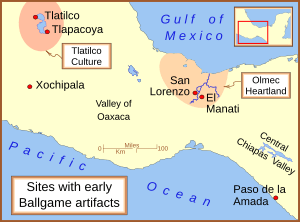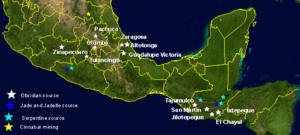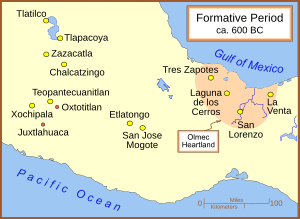Regional communications in ancient Mesoamerica facts for kids
Regional communications in ancient Mesoamerica are believed to have been extensive. There were various trade routes attested since prehistoric times. In this article, especially the routes starting in the Mexico Central Plateau, and going down to the Pacific coast will be considered. These contacts then went on as far as Central America.
The time frame considered is from the earliest times and up to the Late Classical Period (600–900 CE).
Contents
Regional communication

Scholars have long identified a number of similarities between the ancient Guatemalan and Mexican art styles and cultures. These similarities start as far north as the Mexico Central Plateau and continue to the Pacific coast and as far as Central America. There are many common elements in iconography, stone sculptures and artefacts. All this led to the investigation of possible trade patterns and communication networks.
Based on archaeological and ethno historical study in eastern Guerrero since 1998, an important network of roads through the Sierra Madres of Guerrero has been identified. These roads connected the settlements in Morelos and Puebla to the longer Pacific Coast communication and trade route.
It is certain this route played a critical role in the political and economic development of southern Mesoamerica, although its importance varied over time.
There was material and information trade between the Mexico Central Plateau, the Gulf of Mexico and the Pacific Ocean, it is not certain whether it was made through direct contact (15 day or more trips and 15 days to return) or by indirect means (trading goods from community to community, without the high land people ever seeing coastal people).
Roads

Routes from the Gulf of Mexico Mountains and the center of Oaxaca seem to have been constantly open to circulation, since at least the early preclassical period; the Pacific route was apparently blocked at different points, between Chiapas and Oaxaca, for example, during the postclassical period by the Mixtec kingdom of Tututepec on the eve of the Spanish Conquest. One group of epiclassical sculptures indicates iconographic relationships between Morelos and Guerrero, with examples also found in Pacific Coastal Chiapas and Guatemala.
According to Fray Bernardino de Sahagún (1989:267) Mesoamerica prehispanic roads were simple compacted dirt paths, full of stone and limited by surrounding vegetation. Today these roads have disappeared, whether by railway or asphalt roads and freeways or by abandonment at prehispanic times, in addition to normal erosion deterioration, sedimentation and invasion of adjacent vegetation.
Systematic archaeological and ethnic-historical studies in eastern Guerrero from 1998, have demonstrated the existence of an important road network through the mountain ranges of Guerrero, that connected archaeological sites of Morelos and the south of Puebla with a communication and commerce trade route throughout the Pacific Ocean coast.
Historical Routes
Without taking into consideration branches and secondary deviations, there are several routes identified, that connected the center of Mexico with the Guatemala Pacific Coast, one through Puebla and the sierra, and the other through the Guerrero state and the Pacific Ocean coast. Both joined at Juchitán. From Juchitán, again, there were two routes to Guatemala, one on the north that lead to MIxco-Kaminaljuyu and the other on the south that lead to Escuintla.
North Route Tenochtitlan – Juchitán
This route left Tenochtitlan to Puebla, Cholula (Tlaxcala Plateau), Orizaba and down to the "Eastern Sierra Madre" range to Tuxtepec, Matias Romero and from there, towards the Isthmus.
An alternate route from Cholula went southwards, towards Tehuacán, Oaxaca, Monte Albán and down to Juchitán.
Middle Route Tenochtitlan – Juchitán
This route crosses through Oaxaca had two alternatives:
- Via de Tehuacán Valley, through the Cuicatlán and Teotitlán Ravine
- Through the Morelos Valley and then through the Lower Mixteca, Huajuapan de León; as well as Mixteca Alta, Yanhuitlán and Nochistlán.
From the Oaxaca central valleys the route went towards Nejapa, Tequisistlán, and arrived at Tehuantepec, then Juchitán. and.
South Route Tenochtitlan – Juchitán
This route started at Tenochtitlan, south to Morelos, Chalcatzingo and headed east towards the state of Guerrero, passing through Chiautla, Huamuxtitlán, Tlapa and Ometepec, from there headed towards the "Sierra Madre del Sur" and the coast, via Tututepec and Huatulco all the way up to Tehuantepec.
Route Juchitán to Guatemala
From Juchitán to Guatemala there were two routes, north and south.
- The northern route, went from Juchitán to Tapanatepec and then towards "Chiapa de los Indios" (Chiapa de Corzo) and headed towards Comitán and then, in Guatemalan territory, onto Huehuetenango, Quetzaltenango, Chimaltenango and Mixco Viejo.
- The southern Isthmus or Soconusco route continued from Tapanatepec to Tonalá, Pijijiapan, Tuxtla Chico, and then in Guatemalan territory, onto Retalhuleu and down to Santa Lucía Cotzumalguapa, Escuintla.
In spite of the importance of these routes, passage through these routes was blocked by the Mixtec Kingdom of Tututepec, that monopolized it for their own benefit and caused tensions with the political groups of the Mexican Plateau, especially with the Triple Alliance.
See also
 In Spanish: Comunicaciones regionales en la antigua Mesoamérica para niños
In Spanish: Comunicaciones regionales en la antigua Mesoamérica para niños


